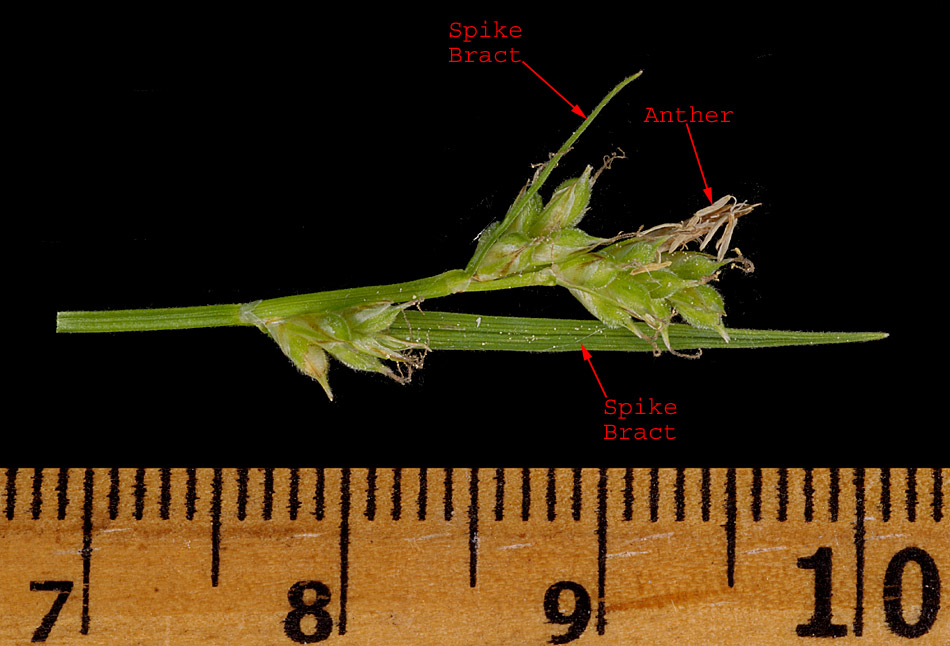 |
Stigmas 3;
achenes three-sided, occasionally terete, though their shape may be
concealed by flattened perigynia; NOT [Stigmas 2; achenes lenticular.] |
 |
Spikes 2
or more per culm, terminal and lateral; spike bracts present on lateral
spikes (except in Section Phyllostachyae), lowest bract usually evident,
often conspicuous. NOT [Spikes 1 per culm, terminal; spikes bracts
absent.] |
 |
Lower
pistillate scales not bract-like or leaf-like but similar in size and
shape to individual perigynia (up to twice as long as perigynia in C
magellanica ssp. irrigua]; NOT [Lower pistillate scales resembling
green, leaf-like bracts much longer and wider than individual perigynia.
Section Phyllostachyae.] |
 |
Perigynia
sparsely to densely pubescent or puberulent (in Carex pedunculata
pubescence represented by very short hairs scattered near tip; in some
species of Sect. Acrocystis, perigynia may be glabrous or virtually
hairless, but all members of this section have convexly 3-sided to
terete achenes with tight-fitting perigynia and a stipe-like base about
equal to beak in length). NOT [Perigynia glabrous (i.e. lacking a
pubescence).] |
 |
Perigynia
usually less than 5 mm long but if longer, beak distinctly shorter than
perigynium body; pubescence various. NOT [Perigynia 5-7 mm long with
beak as long as or longer than perigynium body; pubescence on the
perigynia dense, stiff and pointing toward tip.] |
 |
Achenes
convexly 3-sided to terete; perigynia tightly enclosing achenes and
convexly 3-sided to terete, sparsely pubescent, (rarely glabrous in C.
deflexa and C. rossii, pubescent only on ribs in C. tonsa); stipe-like
base about equal to beak in length; pistillate spike bracts sheathless.
Section Acrocystis. NOT [Achenes with +/- flat sides; perigynia loosely
fitting achene and variously shaped in cross-section, densely to
sparsely pubescent (faintly puberulent with very short hairs scattered
near tip in C. pedunculata); pistillate spike bracts sheathing or
sheathless.] |
 |
All
pistillate spikes cauline, i.e. attached near top of regular, elongate
culms and born at or above level of leaf tips. NOT [Some or all
pistillate spikes basal, i.e. attached near base of plant and borne
among leaf bases.] |
 |
Staminate
spike 3-10 mm long, inconspicuous among pistillate spikes; other
features not as below. NOT [Staminate spike 10-20 mm long, conspicuous
above pistillate spikes; plants in dense tufts with copious fibers on
crown; leaves of vegetative shoots stiff, erect and nearly as tall as
inflorescence; plants of dry prairie.] |
 |
Staminate
spike 5.3-10 mm long; pistillate spikes 2-3 (4); perigynia 3-4 (4.2) mm
long, pubescent; culms (0.7) 1-4.7 dm high, mostly exceeding leaves.
NOT [Staminate spike 3-5 (5.7) mm long; pistillate spikes usually 2;
perigynia 2-2.5 (3.1) mm long, pubescent but may become glabrous with
age; culms 0.4-1.5 (3.1) dm high, shorter or longer than the leaves.] |

